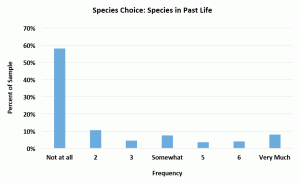In addition to knowing what a person’s fursona species is, people (furry and non-furry) often want to know why a person’s fursona is the species that it is. These stories are often unique, and it would be next to impossible to fully capture the numerous variables that contribute to the species that a furry’s fursona manifests as. To avoid this intractable problem, we instead asked furries to indicate the extent to which they agreed or disagreed that each of a number of possible factors influenced their fursona’s species. While this is by no means a complete list of factors, it does at least capture the variety of factors while also illuminating some of the more popular ones.1
Factor: Innate Connection
It appears that there is quite a bit of variance in responses to this item. One in three furries disagrees that they have an innate connection to their species, but more than 40% of the fandom agrees with the statement at least “somewhat.”
Factor: Trapped in Human Body
Half the furries in our sample completely disagreed with the notion of feeling like their species trapped in a human body, with only about one in three agreeing with it at least “somewhat.” There seems to be a strong distinction between furries who disagree with this item and those who do not, and this item, along with the preceding one, are likely tapping into elements of therianthropy.2
Factor: Shared Characteristics
In general, furries tend to agree with this item—more than 75% state that it is at least somewhat true that they share characteristics with their fursona species. Conversely, about 15-20% of furries say that shared characteristics have little to nothing to do with their fursona species.
Factor: Past Life
Factor: Spirit Guide
The vast majority of furries disagreed with these items. This is perhaps unsurprising, given that these items tap into a spiritual connection with animals, while furries, as a group, are not particularly religious or spiritual.3
Factor: Physical Resemblance
In general, furries disagreed that their fursona species was the result of a physical resemblance, with one-third to one-half of furries disagreeing vehemently with this item. One in five furries did cite physical resemblance as an important part of the relationship they had with their species.
Often, furries and non-furries alike will ask whether certain personalities or traits are associated with particular fursona species (e.g., “are people who choose dog fursonas more loyal?”) To discover the stereotypes people associate with different fursonas, we asked participants in one study to describe their fursona species and then describe 3 traits associated with their species.4
The study revealed that certain popular fursona species had commonly associated stereotypes:
- Dogs (42%) and Wolves (29%) were most commonly associated with “loyalty”
- Foxes (41%) were most commonly associated with being “sly”
- Dragons (19%), tigers (18%) and bears (43%) were commonly associated with “strength”
- Otters (36%) were commonly associated with “fun”
- Rabbits (21%) were commonly associated with being shy
- Cats (14%) were commonly associated with being lazy
- The species most commonly associated with sex / promiscuity was rabbits (10%)
While these results describe the stereotypes that people associate with different fursona species, they don’t actually provide any evidence as to whether furries who pick these fursona species actually embody these traits. In a follow-up study,5 we tested exactly that: are people who choose these common fursona species more or less likely to actually identify with these terms? The questions were asked covertly (e.g., buried amidst many other personality traits, not asked about with regard to one’s fursona species).
The data suggests that several of the stereotypes may, in fact, be true: compared to furries with other fursonas, those whose fursona included a wolf or a dog were significantly more likely to use the word “loyal” to describe themselves. Similarly, those with a fox fursona were also far more likely to use the word “sly” to describe themselves than those whose fursonas were not foxes. Furries with bear fursonas were more likely than other furries to call themselves “strong”, as were wolves—tigers and dragons were not significantly more likely to do so, despite the stereotype. Furthermore, foxes and cats actually scored significantly lower on strength than other furries.
There was little evidence to support any of the other stereotypes. In fact, the data suggested several unexpected findings: wolves and dogs were more promiscuous than foxes or any other species, and foxes (but not rabbits) scored significantly higher on shyness. In addition, there exists a common stereotype in the fandom about foxes being particularly promiscuous and more likely to be homosexual than other fursona species. In fact, there is no evidence to support this, although data do suggest that furries with dog fursonas are more likely to be non-heterosexual and are more likely to be in a relationship than furries with other fursonas.
Finally, data suggest that while most fursona species are equally preferred by men and women in the fandom, there are a few species that show sex differences: foxes and bears are significantly more likely to be chosen by males, while cats are significantly more likely to be chosen by females.







Recent Comments